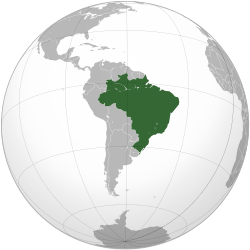This article needs additional citations for verification. (November 2020) |
You can help expand this article with text translated from the corresponding article in Portuguese. (September 2011) Click [show] for important translation instructions.
|
Republic of the United States of Brazil República dos Estados Unidos do Brasil | |||||||||
|---|---|---|---|---|---|---|---|---|---|
| 1889–1930 | |||||||||
| Motto: Ordem e Progresso "Order and Progress" | |||||||||
| Anthem: | |||||||||
 Brazil at its largest territorial extent, including Acre | |||||||||
| Capital | Rio de Janeiro | ||||||||
| Common languages | Portuguese | ||||||||
| Government | Military dictatorship (1889–1894) Oligarchic federal presidential republic (1894–1930) | ||||||||
| President | |||||||||
• 1889–1891 | Deodoro da Fonseca (first) | ||||||||
• 1926–1930 | Washington Luís (last) | ||||||||
| Vice President | |||||||||
• 1891 | Floriano Peixoto (first) | ||||||||
• 1926–1930 | Melo Viana (last) | ||||||||
| Legislature | National Congress | ||||||||
| Senate | |||||||||
| Chamber of Deputies | |||||||||
| Historical era | Belle Époque | ||||||||
| 15 November 1889 | |||||||||
| 24 February 1891 | |||||||||
| 1893–1894 | |||||||||
| 1893–1895 | |||||||||
• Civilian rule | 15 November 1894 | ||||||||
| 3 November 1930 | |||||||||
| Population | |||||||||
• 1890 | 14,333,915 | ||||||||
• 1900 | 17,438,434 | ||||||||
• 1920 | 30,635,605 | ||||||||
| Currency | Real | ||||||||
| ISO 3166 code | BR | ||||||||
| |||||||||
| Part of a series on the |
| History of Brazil |
|---|
 |
|
|
The First Brazilian Republic, also referred to as the Old Republic (Portuguese: República Velha, Portuguese pronunciation: [ʁeˈpublikɐ ˈvɛʎɐ]), officially the Republic of the United States of Brazil, refers to the period of Brazilian history from 1889 to 1930. The Old Republic began with the coup d'état that deposed emperor Pedro II in 1889, and ended with the Revolution of 1930 that installed Getúlio Vargas as a new president. During the First Republic, the country's presidency was dominated by the most powerful states of São Paulo and Minas Gerais. Because of the power of these two states, based on the production of coffee and dairy, respectively, the Old Republic's political system has been described as "milk coffee politics". At local level, the country was dominated by a form of machine politics known as coronelism, in which the political and economic spheres were centered around local bosses, who controlled elections.
The country was also marked by a series of rebellions and revolutions against the ruling oligarchies, which culminated into the Revolution of 1930, when the Liberal Alliance, a force of urban middle-class, planters from outside São Paulo and military reformists composed mostly by junior officers (known as Tenetism), deposed ruling president Washington Luís (representative of the São Paulo oligarchies) and led to the ascension of Getúlio Vargas as president, heralding the start of the Vargas Era.

